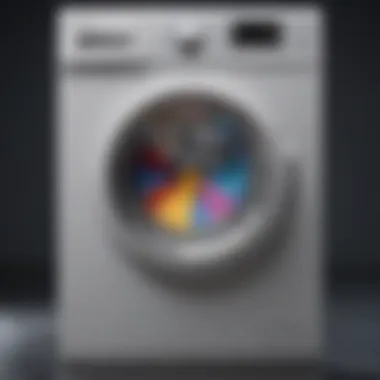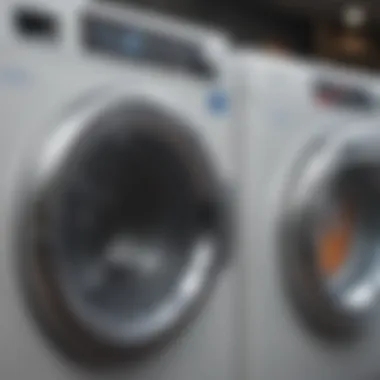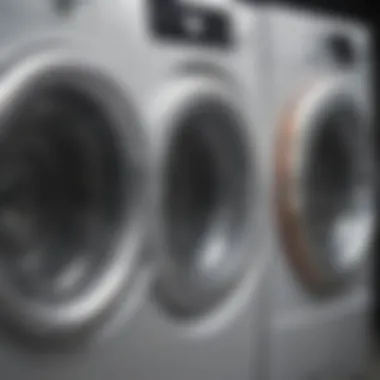Deciphering Washing Machine Symbols for Effective Laundry


Intro
Understanding the symbols on a washing machine is not merely a matter of convenience; it's a critical component of effective laundry care. Each icon represents specific functions and settings that can significantly influence the outcome of your laundry routine. This guide aims to provide clarity on the myriad of symbols found on washing machine dials and labels, making laundry a more straightforward task.
Customization of washing machines has evolved in line with technological advancements and user needs. Beyond general use, these symbols also cater to diverse fabric types and specific cleaning requirements. The absence of comprehension can lead to mishaps, such as damaging clothes through improper settings. Therefore, familiarizing oneself with these icons can enhance garment longevity and ensure optimal results with minimal effort.
As we embark on this exploration, we will dissect various categories of symbols—ranging from washing cycles to temperature settings and drying instructions. Each section will provide a detailed understanding of what these symbols signify and how they affect your laundry experience. This article is tailored for homeowners and laundry enthusiasts who seek to improve their laundry techniques and home management.
In the following sections, readers can expect to delve deeper into the meanings of each symbol, unravel the common misinterpretations, and gain insights into best practices that will lead to efficient laundry habits.
Prologue to Washing Machine Symbols
Understanding the symbols on your washing machine is essential for effective laundry management. This section addresses the importance of these symbols and provides an overview of their common types. Grasping what each symbol means can prevent garment damage and improve the efficiency of laundry routines. Without this knowledge, one risks using the wrong settings, which can lead to shrinking, fading, or even ruining garments.
Importance of Understanding Symbols
Laundry symbols are not arbitrary. They serve specific functions that, when properly understood, enhance the overall laundry experience. For homeowners, knowing these symbols can reduce frustration and save time. If someone uses the wrong cycle, it can result in excessive wear on fabrics or ineffective cleaning. By understanding symbols, a user can prolong the lifespan of their clothing, reduce costs associated with replacement, and avoid the inconvenience of mishandled loads. This knowledge empowers users to operate their washing machines more effectively, creating a well-managed home environment.
Overview of Common Types of Symbols
Washing machines feature a variety of symbols, each representing different aspects of the laundry process. Common types include:
- Washing Symbols: Indicating cycle types and water temperature settings. This directly influences fabric care and cleaning efficacy.
- Drying Symbols: Illustrating options for drying, such as air dry or tumble dry, which guide the user in proper garment care after washing.
- Special Care Symbols: These provide additional care instructions for delicate fabrics, such as the gentle cycle, ensuring garments receive appropriate treatment.
Familiarizing oneself with these symbols lays the groundwork for effective laundry practices. As such, prioritizing this knowledge is a wise choice for any homeowner.
Washing Symbols Explained
Understanding washing symbols is vital for anyone who uses a washing machine. These symbols guide users on how to properly wash their clothes, ensuring they maintain the quality and longevity of garments. Familiarity with these icons can help avoid common laundry mistakes that may lead to damage, shrinking, or discoloration. Each symbol represents specific washing instructions that, if followed, can prevent costly errors and extend the lifespan of your clothing.
General Washing Instructions
General washing instructions are often represented by simple symbols on the machine or care labels. These symbols indicate the overall approach to washing, helping users to quickly decide the appropriate cycle for their items. General symbols inform about the kind of attack that clothes can endure in a wash cycle, from machine washing to hand washing. Understanding these instructions saves time and effort, allowing for efficient laundry routines.
Specific Cycle Symbols
Specific cycle symbols provide detailed guidance on the different washing programs available on a machine. Each cycle is tailored for various fabric types and soil levels, which means selecting the right one enhances cleaning and protects the garment.
Normal
Normal cycle is designed for everyday fabrics such as cotton and linen. Its key characteristic is its use of a standard agitation pattern combined with an average wash time. This cycle is popular because it balances cleaning efficiency with garment care. The unique feature of the Normal cycle is its effectiveness in removing dirt and stains without extreme wear on clothes. However, users should avoid using this setting for delicate fabrics, as it may cause damage.
Delicate
The Delicate cycle is suitable for lighter, fragile items such as silk and lace. It uses a gentler wash action and less spin speed. This cycle is beneficial for items that require extra care to maintain shape and texture. The unique feature of the Delicate cycle is its reduced agitation, minimizing fraying or tearing fabrics. Still, it may not be effective for heavily soiled clothes.
Heavy Duty
Heavy Duty is aimed at robust fabrics like towels or heavily soiled work clothes. Its key characteristic is a vigorous wash action designed to lift tough stains and dirt. This cycle is favorable for users with demanding laundry tasks. The Heavy Duty cycle's unique feature is its longer wash time and increased agitation, which ensures a deep clean. Users should note that frequent use can lead to faster wear on sensitive fabrics.
Hand Wash
The Hand Wash cycle mimics the gentleness of hand washing, making it ideal for wool and other knits. Its key trait is low agitation and gentle spin, protecting garments from felting and distortion. It is a beneficial choice for those who possess delicate clothing requiring careful handling. The unique feature of the Hand Wash cycle is that it allows users to wash delicate fabrics without the risk of machine damage, yet this cycle may not clean as thoroughly as other options.


Water Temperature Indicators
Water temperature indicators are crucial for determining how heat affects fabric care. These indicators help prevent damage caused by washing at incorrect temperatures, ensuring the longevity of garments.
Cold
The Cold setting is used primarily for delicate fabrics or items that may bleed colors. This cycle has a significant advantage of conserving energy, as it uses unheated water. One of the unique features of washing in cold water is that it can minimize shrinkage and prevent colors from fading. However, it may not be as effective on heavily soiled items.
Warm
Warm water is often the best choice for a balanced wash, suitable for most fabrics. This temperature provides a good mix of cleaning power while being gentle enough for general use. The unique aspect of using warm water is its ability to dissolve detergents effectively while also lifting soil. Nonetheless, certain sensitive fabrics could still be at risk of damage.
Hot
Hot water is ideal for microfiber towels and heavily soiled items like bedding. This setting enhances cleaning power significantly, allowing for the best results in odor and stain removal. Hot water's unique feature includes sanitizing items, an essential benefit for hygienic purposes. However, hot washing can cause shrinking and fading, which users must consider when selecting this option.
Drying Symbols and Their Meanings
Understanding drying symbols is crucial in the overall care of laundry. Drying symbols provide guidance on how to properly use a dryer and avoid damage to clothing. Not all fabrics can withstand the same level of heat or drying method. Misinterpretation of these symbols can lead to shrinkage, distortion, or other irreversible fabric damage. Therefore, recognizing and applying these symbols ensures that garments remain in good condition and last longer, making a significant difference for homeowners who prioritize laundry care.
Drying Cycle Options
Drying cycle options vary by washing machine brand and model. These options can significantly affect how garments are dried. Here are some common drying symbols you might encounter:
- Tumble Dry: This symbol indicates that you can use a tumble dryer to dry the garment. Tumble drying can be done on high or low heat, depending on the specific care label instructions.
- Do Not Tumble Dry: A circle with a "x" through it signifies that the item should not be placed in a dryer. Instead, air drying is recommended to prevent damage.
- Dry Flat: This means that the item should be dried flat on a surface to maintain its shape. This is often seen for delicate or knit items.
- Hang to Dry: The symbol suggests that the item should hang to dry. This is often a safe method for many types of fabrics, particularly those prone to shrinking or stretching.
Being aware of each option enhances laundry efficiency and garment longevity.
Air Dry vs. Tumble Dry
When choosing between air dry and tumble dry, it is important to recognize their distinct effects on clothes. Each method has its own advantages and drawbacks.
- Air Dry: This method is gentle on fabrics. It reduces the risk of wear and tear caused by heat and movement in a dryer. Air drying is particularly suitable for:
- Tumble Dry: This method involves machine drying. It is faster but can be harsher on fabrics. Tumble drying is appropriate for:
- Delicate fabrics like lace or silk
- Items with embellishments or prints that may be damaged by heat
- Garments that may shrink in the dryer
- Cotton and polyester blends which hold up better under heat
- Towels and bedding which are often designed to withstand high heat
- Items that need to be dried quickly.
Ultimately, selecting the correct drying method is critical in maintaining the integrity of clothing.
Always refer to the care labels on your garments, as they provide specific guidance tailored to the fabric’s needs.
Special Care Symbols
Understanding special care symbols is vital for maintaining the integrity of your laundry. These icons provide specific instructions that cater to delicate fabrics and unique garment requirements. Misinterpretation can lead to irreversible damage, therefore, understanding these symbols ensures that clothes remain in good condition. Knowing when to use gentler washing cycles or when to avoid certain laundering methods can significantly impact the lifespan of your clothing.
Gentle Cycle Symbol
The gentle cycle symbol is essential for items that require extra care. This symbol often looks like a hand in water, indicating that a specific washing process should be used. When this symbol is present, it suggests that the fabric is sensitive and can easily be damaged by more vigorous washing cycles.
Key points regarding the gentle cycle symbol:
- It applies to delicate fabrics such as silk, lace, or some synthetic materials.
- Using this cycle minimizes agitation, reducing wear and tear on fabrics.
- Items should be placed inside a mesh laundry bag for additional protection.
No Spin Cycle


The no spin cycle is marked by a circle with a line through it. This instruction serves an important purpose, especially for garments that may stretch or lose shape if subjected to standard spin cycles. Items like wool sweaters or certain knit fabrics are best washed using this setting.
Consider these points related to the no spin cycle:
- It helps maintain the garment's original shape and prevents damage.
- Clothes will retain more water but will be gentler on delicate fabrics.
- After washing, air drying is commonly recommended for garments treated this way.
Bleaching Instructions
Bleaching instructions are vital for determining which items can withstand such treatments. Not all fabrics are suitable for bleach, and using it improperly can ruin a garment. This symbol typically looks like a triangle, sometimes with an additional indication of safe bleach use.
The key aspects regarding bleaching instructions include:
- Do Not Bleach: This denotes that bleaching agents should be avoided completely.
- Non-Chlorine Bleach: Some garments allow the use of non-chlorine bleach as a cleaning agent.
- It is crucial to carefully read the bleaching label before applying treatments to avoid irreversible harm.
"Understanding these symbols is as important as knowing the fabric you wear. Take time to learn and apply these instructions — your clothes will thank you."
By grasping the importance of special care symbols like these, homeowners can assure they are doing laundry properly. This knowledge not only safeguards their investments in clothing but also contributes to a more efficient laundry process.
Fabric Care Symbols
Understanding fabric care symbols is crucial for maintaining the integrity of your garments. Each symbol provides essential guidance on how to handle specific fabrics, from washing to drying and ironing. By following these symbols, you can prolong the life of your clothes and ensure they remain in good condition.
Understanding Fabric Symbols
Fabric symbols are like a universal language for laundry care. They indicate how to treat different materials based on their unique properties. Knowing these symbols can help you avoid mishandling and damage.
- Purpose: These symbols inform you about the correct washing temperature, drying methods, and ironing settings.
- Benefits: Following the instructions can prevent the shrinking, stretching, or fading of fabrics. You save money on replacements and enjoy the longevity of your favorite items.
Common Fabric Symbols
Fabrics have their identities represented through specific symbols. Let's explore three common fabric symbols: cotton, wool, and polyester.
Cotton
Cotton is one of the most popular fabrics around the globe. Its symbol represents durability and comfort. The key characteristic of cotton is its softness and breathability. This makes it a favored choice for everyday clothing.
- Unique Feature: Cotton is highly absorbent, which allows it to wick moisture away from the body.
- Advantages/Disadvantages: While cotton can be machine washed, it is prone to shrinkage if washed in hot water. Understanding this helps you adjust settings to avoid issues.
Wool
Wool is another significant fabric, mostly used in colder climates. The symbol for wool is distinctive and indicates delicate handling. The key characteristic of wool is its natural warmth and elastic properties. This fabric is ideal for sweaters and outerwear.
- Unique Feature: Wool fibers can regulate temperature, keeping you warm in cold conditions.
- Advantages/Disadvantages: Although soft and insulating, wool often requires special care, such as hand washing or dry cleaning, to avoid felting or damage.
Polyester
Polyester has gained popularity due to its versatility. It is often blended with other fibers for enhanced durability. The symbol for polyester is less complex, indicating machine washability and quick drying.
- Unique Feature: Polyester resists wrinkles, making it a low-maintenance fabric option for many applications.
- Advantages/Disadvantages: While polyester is durable and stain-resistant, it can retain odors if not washed properly. Awareness of this helps in maintaining freshness in garments.
Ensuring you understand fabric care symbols is essential for effective garment maintenance. Not only does it aid in preserving your clothes, but it also helps you make informed choices when shopping.
Common Misinterpretations
Understanding the symbols on your washing machine is essential for proper laundry care. However, many homeowners tend to misinterpret these symbols, which can lead to unintended consequences. Misreading washing machine symbols may result in damage to clothes, inefficient washing cycles, or even wasting energy. Therefore, it is crucial to identify common misinterpretations of these symbols and understand their real meanings. This section aims to illuminate key examples of such misinterpretations and their repercussions, aiding readers to navigate this often-intricate aspect of home management with greater confidence.


Symbol Misreading Examples
Misreads often occur due to varying interpretations of similar symbols across different washing machine brands. Here are a few common misreading examples:
- Hand Wash Symbol:
The hand wash symbol may be mistaken for the gentle cycle, but they are not the same. The hand wash indicates extreme care for delicate items, while the gentle cycle allows for some agitation. - No Spin Symbol:
Misunderstanding this symbol can lead to unexpected wet clothes after washing. This symbol means that the machine will not spin at all, which is often required for gentle fabrics. Users might think it is for automatic spin reduction and ignore it. - Bleaching Symbols:
The different types of bleach symbols can cause confusion. Some symbols indicate safe use of oxygen bleach, while others suggest the use of only non-chlorine bleach. Misusing bleach can ruin fabrics. - Dry Cleaning Symbol:
The dry-cleaning symbol might be interpreted as safe for home washing, which is incorrect. It specifically recommends professional cleaning. Confusing this can lead to damaging sensitive fabrics. - Temperature Indicators:
Reading the temperature indicator symbols can also lead to errors. A hot-water symbol may be misread as warm by those unfamiliar with the graphics, leading to possible harm to heat-sensitive garments.
Consequences of Misinterpretation
Misreading washing machine symbols can have several ramifications:
- Garment Damage: Misinterpreting cycles or temperatures can lead to shrinking, fading, or even fabric breakdown.
- Increased Costs: Using incorrect settings often results in additional washing cycles, wasting both time and energy costs.
- Reduced Lifespan of Items: Damage from improper care can significantly decrease the lifespan of clothing, which is particularly important for more expensive or cherished items.
- Frustration and Waste: Dealing with damaged laundry can be both frustrating and wasteful. This may result in unnecessary replacement of clothing and resources.
By understanding common misreading examples and their consequences, homeowners can take proactive steps to ensure they correctly interpret washing machine symbols. This knowledge is invaluable for maintaining both garments and the washing appliance itself.
"Always refer to the manufacturer's guide for specific symbols related to your washing machine model."
In summary, proper recognition of washing symbols can prevent the negative outcomes that arise from misinterpretations. This guides the reader toward more confident and effective laundry care.
Resources for Further Learning
Understanding washing machine symbols requires both study and practice. Readers seeking to deepen their knowledge will find various valuable resources. This section emphasizes the importance of leveraging these resources to enhance laundry practices.
Access to quality information ensures that users make informed decisions about their laundry care. Manufacturer manuals serve as an essential guide. These manuals provide specific details about each washing machine model, including settings and features. Commonly overlooked, they often hold information unique to the appliance users own.
Manufacturer Manuals
Manufacturer manuals are often the first point of reference for users. These documents typically accompany the washing machine when purchased, but they can also be found online. Manuals usually cover:
- Specific symbol meanings related to the model.
- Recommendations for optimal cycles and settings.
- Maintenance tips to keep the machine functioning well.
It is vital to refer to these manuals when unsure about what a particular symbol signifies. Often, the symbol functions may differ between models from different brands. This can lead to improper use and potential damage to garments or the machine itself. Being informed about these details can facilitate a more effective laundry routine and prolong the life of clothes.
Online Resources and Guides
In addition to manual references, online resources are an excellent avenue for further learning. Several websites contain extensive information regarding washing machine symbols. These resources often include:
- Detailed articles explaining various symbols. Websites like Wikipedia and Britannica can provide valuable insights.
- User forums, such as Reddit, where individuals share experiences and advice on using washing machines effectively. This communal knowledge can assist in understanding practical applications and real-life examples.
- Video tutorials that visually demonstrate how to interpret symbols, making the learning experience more engaging.
Utilizing these online guides enhances understanding, providing practical context that might not be present in manuals. By blending traditional references with digital platforms, users can fully grasp the significance of the symbols on their washing machines.
"Knowledge is power, especially when it comes to optimizing laundry routines."
Finale
Understanding washing machine symbols is not just an exercise in familiarity, but a foundational skill that enhances your laundry's efficiency and longevity. This article sheds light on the intricate meanings behind these symbols, which often go overlooked. By grasping the nuances of washing symbols, a user can avoid the pitfalls of improper care, such as color fading or fabric damage. Such knowledge can ultimately lead to cost savings through reduced wear and tear on garments.
Recap of Key Learnings
Throughout this guide, we explored various symbols that govern washing, drying, and fabric care. Key takeaways include:
- Washing Cycle Symbols: Different cycles cater to specific fabric needs, ensuring proper agitation and spin settings.
- Water Temperature Indicators: Recognizing temperature symbols is vital for preventing shrinkage or set stains.
- Drying Instructions: Misinterpretation can lead to garments being damaged or improperly dried, thus shortening their lifespan.
- Special Care Symbols: Knowing when to employ gentle cycles or avoid bleaching can extend the utility of fabrics. These insights provide a roadmap for better laundry practices, promoting a more mindful approach to garment care.
Encouragement for Practical Application
Arming oneself with the knowledge of washing machine symbols is a step towards informed laundry choices. It is crucial to translate this understanding into action. Examine your garments and familiarize yourself with all symbols presented on their labels. Integrating this knowledge into your laundry routine can lead to tangible benefits, such as improved garment quality and efficiency in cleaning.
In practice, take time to decode the symbols before loading your washing machine. Make a habit of adjusting cycle settings according to the specific symbol instructions on your clothing tags. Engaging with fabric care in this manner elevates your overall home management, ensuring each piece of clothing receives the appropriate treatment.
"Understanding the symbols on your laundry labels is like having a personal laundry assistant—guiding you to make the best choices for your garments."
By applying what you have learned in this guide, you will not just enhance your washing practices but also cultivate a deeper respect for the care of your clothing, blending knowledge with daily tasks.















